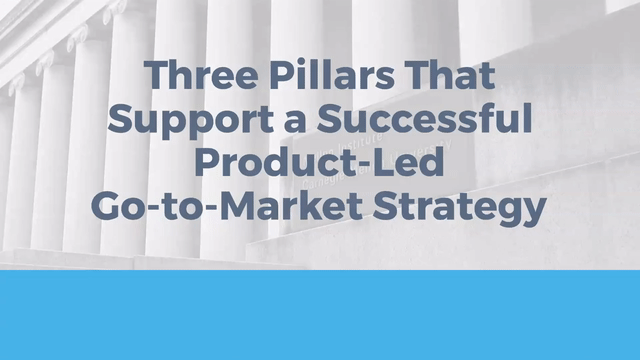Leading a go-to-market strategy can feel like a hailstorm. You’re getting drilled with feedback and opinions. A barrage of goals is peppering you from every direction. And all the while, the pressure of launching a successful go-to-market strategy is forming all around.
Luckily, by rooting your plans in a product-led approach, you can focus your efforts and drive forward with confidence. There are three pillars to support your product-led go-to-market strategy and lead your team to success.
Why perfect your product-led go-to-market strategy?
You probably already know how critical a sound go-to-market strategy is. What you may not realize is how beneficial it is to anchor your plans in a solid product-led plan. Here are some benefits of using product-led growth strategies to fuel your efforts:
-
- A product focus is a customer focus. When you use user data to inform decisions, it lines your strategy up with the customer experience—and that can boost growth. In fact, a Dimension Data study found 84% of companies that proactively work to improve customer experience see a revenue increase.
- You save time and money. By focusing on improving your product and user experience, you spend less time and money searching for new customers. Instead, you lift the value of existing users, lower acquisition costs, and turn your users into advocates for your product.
- The market is begging for product-led strategies. The current SaaS market is rewarding product-led strategies. In fact, Forrester found product-led growth companies post twice the median enterprise value of the public SaaS index as a whole. A big reason for this is the very nature of the market. As more and more companies move to freemium, subscription, and recurring revenue models, it just makes more fiscal sense to focus on improving the product and user experience.

What are the three pillars of a successful product-led go-to-market framework?
Looking for a go-to-market framework that steadies your plans? There are three product-led growth pillars you can lean on:
1. Your In-Product Data
In-product data reveals how users and potential customers are interacting with your product. Not only does this window into the user experience help you see upsell opportunities, but it also gives you a firm set of figures to back your decisions.
When it comes time to nail down priorities for your go-to-market strategy, in-product data unveils how moves will affect the user’s experience. And that keeps your product goals in line with the broader organization. After all, the better the user’s experience is, the shorter time to value (TTV) will be, and the more profit your company will see.
Wondering what in-product data will lend the biggest boost to your GTM strategy? Here’s where to focus:
- Customer profile data
- Customer behavior data
- Production data
2. Your Engagement Machine
The best go-to-market strategies stand on data and are driven by quick actions. One of the best ways to set up those moves is to construct an engagement machine within your product. As a product leader, you can start by embedding in-app engagements and guides into your product experience. Here’s an example of how this type of proactive strategy looks:
Imagine you’ve looked at in-product data and spotted a sticky feature that users love. However, through path analysis, you also see that new users aren’t touching that sticky feature, even while advanced users flock to it. This may indicate that new users don’t have enough information about that feature from the get-go. By dropping in-app guides at strategic points in the user’s journey, you could educate new users, lift engagement, and increase adoption.
At the same time, by embedding customer feedback loops into your product experience, you ensure you’re capturing the user’s experience as you launch and improve features. These loops pump feedback to your team, which you can use to enhance the product. Then you can test the next batch of improvements. This feedback engine is fueled by the user experience and keeps driving deeper and deeper engagement.
3. Your Experimentation Engine
In the modern SaaS world, you need to quickly improve your product and deliver an experience that users want. That’s why automated experimentation sits firmly as the cornerstone of any modern successful go-to-market strategy.
However, building an experimentation engine means more than just conducting A/B testing. Instead, your team needs to set up automated experimentation at a high level. For instance, if you decide to improve onboarding, you may choose to create three separate onboarding experiences for three separate customer cohorts. From there, you could run real-time tests on every new sign-up and determine what the most thorough route to onboarding really is.
This same approach to testing and experimentation can improve user experiences at every stage—be it onboarding, adoption, retention, growth, or any other piece of your go-to-market strategy.
Learn How to Execute Product-Led Success
Now that you understand the pillars of creating a successful product-led go-to-market strategy, it’s time to continue your product-led growth learning by downloading our e-book, Product-Led Success: The Professional’s Handbook for a look at how businesses are thinking about how to scale while improving customer experience to match rapid growth.

